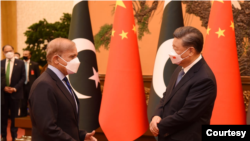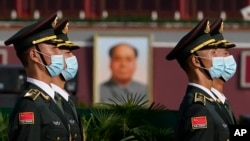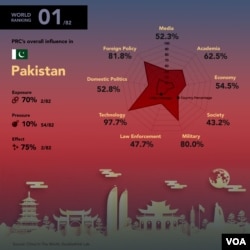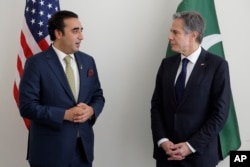A new study on China’s global influence puts Pakistan at the top of the list.
Cambodia and Singapore are in second and third place respectively as the “most exposed” to Beijing’s influence. Among the top 10 countries most exposed to influence by China, eight are in Asia. Paraguay, North Macedonia and Albania were ranked as ‘least influenced.’
The China Index 2022 explores China’s influence in 82 countries by asking experts to respond to questions about China’s activities in their country. The study was conducted and published by the China in the World (CITW) network, an initiative of Taiwan-based anti-disinformation group, Doublethink Lab.
The report asked questions across nine domains to assess each country’s exposure to Chinese influence.
The domains included media, academia, economy, society, military, law enforcement, technology, domestic politics and foreign policy. Some of Beijing’s activities abroad included paid trips for government officials, scholarships for students, journalism training, research funding, trade, investment and military cooperation.
Puma Shen, chairperson of Doublethink Lab told VOA this research lets people around the world see how China approaches their country.
“By comparing all these rankings and comparing all the different strategy, all these countries could learn [about] each other, like how to counter Chinese influence operations,” he said.
Measuring China’s influence
The report measures influence through three indicators, ‘exposure,’ ‘pressure’ and ‘effect.’
Exposure to China’s initiatives abroad make a country vulnerable to China’s influence, for example, economic dependence or receiving other benefits.
How much ‘pressure’ China puts on a specific country includes either direct or indirect actions by Beijing with the aim of altering people’s behavior.
The actual impact or the extent to which a country accommodates China’s demands, is described as ‘effect’ in the study.
Pakistan ranks #1
Pakistan, the county most exposed to China’s influence in the Index received a 70% rating on exposure, 10% on pressure and 75% on effect. However, the report says these percentages “do not suggest some degree out of a “completely influenced” level of 100%. The percentages express the country’s score out of the total achievable amount based on the indicators for each domain.”
According to the report, China’s influence in Pakistan is most active in the domains of technology, foreign policy and military.
Pakistan-China ties
Experts said it is not surprising to see Pakistan at the top of the China Index 2022 as both share an almost 600 km (373 miles) border with each other and a historic rivalry with India.
Decades old strategic ties between the two have deepened since the U.S. ramped up efforts to bolster India to counter China’s growing ambitions in the Indo-Pacific region.
“We cannot decouple and only look at Pakistan and China because to be fair, you also have to look at how the U.S. and India are also working it because there is also this sort of strategic quadrilateral relationship” said Syed Muhammad Ali, non-resident scholar at the Washington-based Middle East Institute.
Others point out that Pakistan’s closeness with China is also a result of Islamabad’s ties with the West cooling off, especially during the last decade.
Arif Rafiq, President of Vizier Consulting, a political risk advisory company told VOA for Pakistan, China is filling a void left by the West.
“China provides Pakistan with goods and materials and funds that it can't get from elsewhere, …that includes military hardware, …advanced technologies related to satellite remote sensing, and also includes funding for electric power plants and infrastructure,” said Rafiq.
In recent years the two countries have struck deals to jointly build submarines and fighter jets. Between 2017 and 2021, Pakistan imported 72% of its major arms from China according to the Sweden-based Stockholm International Peace Research Institute.
While the China Pakistan Economic Corridor (CPEC) launched in 2015 is considered the jewel in the crown of Beijing’s global Belt and Road Initiative with roughly $60 billion worth of infrastructure and energy projects, in October local media reported Beijing and Islamabad also agreed to officially launch three new corridors in the areas of agriculture, health and technology.
Pakistan’s top spot on the China Index 2022 also shows Beijing’s reliance on Islamabad, said Michael Kugelman, deputy director of the Asia program at Washington’s Wilson Center.
“These results highlight the fact that the strategic interests of China require a significant level of engagement and influence building with Pakistan,” Kugelman said.
He pointed to CPEC, which not only brought much-needed investment to Pakistan but also gives China access to Central Asian markets through the deep seaport of Gwadar in southern Pakistan.
China’s soft power in Pakistan
Beijing also exercises soft power through initiatives that include Confucius Institutes, which teach Chinese language and culture, and provides funding for thinktanks and scholarships to court the Pakistani people, the research notes.
“China has historically had to make a lot of efforts to, not to say infiltrate, to really build out its influence across Pakistani society, to try to gain Pakistani trust,” said Kugelman.
Views critical of China being kept out of mainstream Pakistani media, military officials pushing for cooperation with China, and Pakistan purchasing Chinese-made surveillance cameras were among some of the effects of the exposure to Beijing, the report found.
China, Pakistan, US
However, analysts VOA spoke to differ on the long-term societal impacts of China making inroads in Pakistan.
While Kugelman expressed concern that anti-democratic practices like surveillance could increase, Rafiq said that Pakistan’s military and intelligence already engage in authoritarian practices and do not need inspiration from China.
“The U.S., because of its Hollywood and everything else, exerts a much larger cultural, socio-economic influence still on the country,” said Ali of the Middle East Institute.
Despite bilateral efforts to build on the “all-weather friendship,” the Brookings Institution’s Madiha Afzal told VOA via email that “there are signs that the [Pakistani] state has realized some of the disadvantages of an excessive dependence on China and sought to diversify its options – making overtures to the United States, for instance.”
Pakistani military and political leaders say their country would not like to choose between the U.S. and China.
Pakistan owes the largest portion of its external debt to China, roughly 30%. While Beijing helped provide a chunk of much-needed funds, Islamabad sought a bailout from the International Monetary Fund this summer to avoid defaulting on loan repayments.
The biggest donor to the IMF is the U.S.
Methodology
Some experts have raised questions about the methodology used for compiling the China Index 2022.
Berlin-based Tim Ruhlig of the German Council on Foreign Relations helped gather data from Sweden for the index said it was unclear when an “exposure” would be considered strong or weak.
Shen said to standardize the results, researchers were asked to provide supplemental notes and evidence of exposure which Doublethink reviewed against its own criteria to accurately assess the level of exposure.












